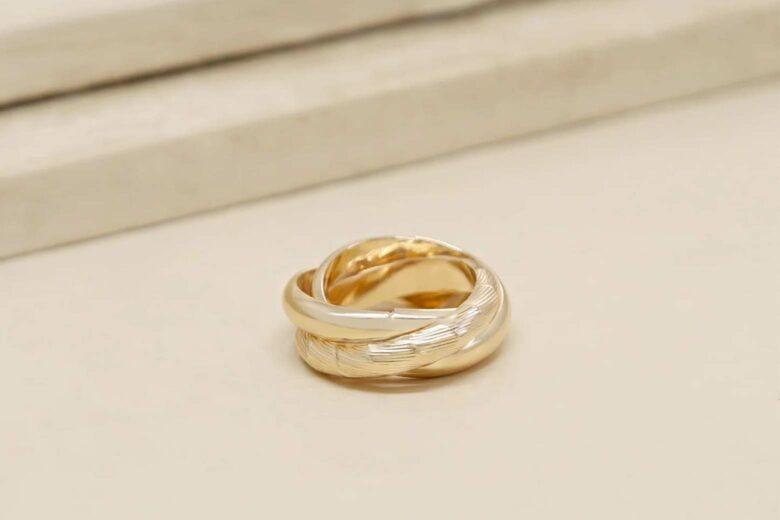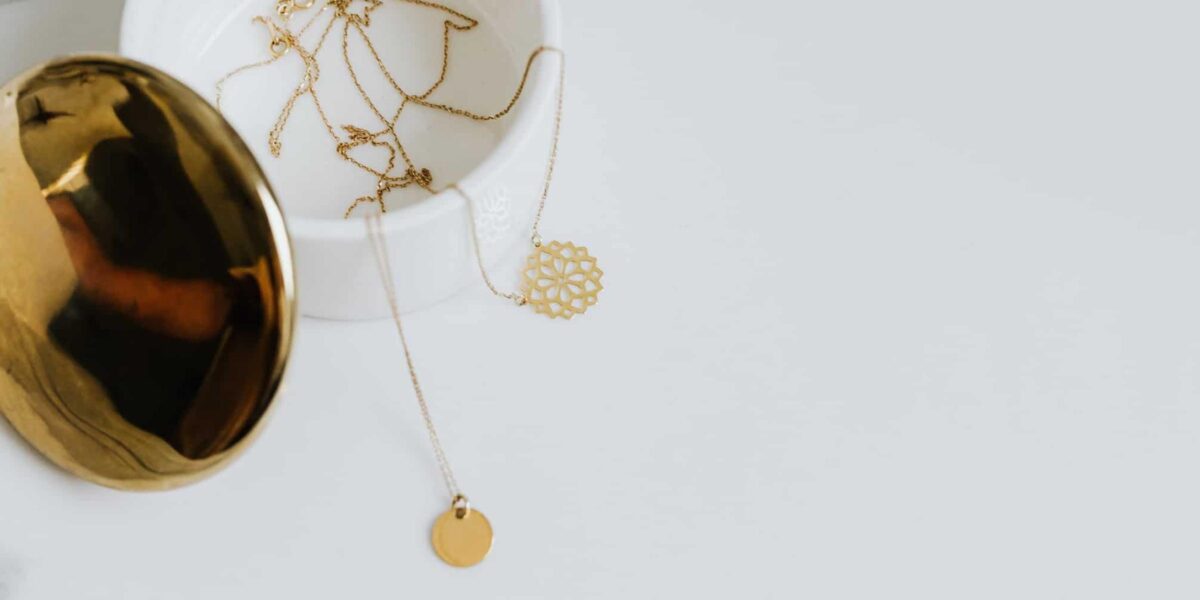Gold plated jewelry may not have the best reputation, but when it comes to the best jewelry brands, they really step up to the plate (sorry we had to.) And while there are many cheap fast fashion knock-offs that aren’t worth a second glance, there are also higher quality pieces that are considered great value for money.
Because that’s what gold plating is really all about—affordability. If you’re hoping to invest in the next family heirloom, look the other way. But if you just want a luxury-looking, low-cost statement piece to wear on occasion, gold plated jewelry may just be the answer.

What does gold plated mean?
Instead of solid gold, gold plated means that a base metal has been coated using a thin layer of gold. Gold plating can look very similar to solid gold but is a fraction of the price, making it an enticing option for statement pieces or occasion wear.
So what’s the problem? Unlike gold vermeil and gold filled jewelry, gold plated jewelry isn’t regulated. This means that there are no strict requirements that need to be met in order to call something “gold plated,” and many jewelry brands try to get away with the bare minimum.
The most common process used for jewelry plating is electroplating.
Electroplating is a chemical process that involves an electric current passing through a solution that contains gold ions. The gold ions then become attracted to the base metal in the jewelry piece, which then causes them to bond with the surface of the metal. Because this is a chemical reaction, it is a lot longer lasting than cheaper alternatives like flash plating.
Flash jewelry plating is not a chemical reaction and the layer of gold is usually a lot thinner, meaning that it fades a lot quicker.
Because gold plating isn’t regulated, gold thickness and base metals vary hugely from one piece to another. This will hugely impact the durability and value of individual jewelry pieces.
Jewelry with a thicker layer of gold will last a lot longer than pieces with a thinner layer.
When it comes to base metals, sterling silver bonds the best with gold ions, making for the highest quality gold plated jewelry. The best part about gold plating is that it is usually the most affordable alternative to solid gold. However there are no guarantees that the piece will last very long, therefore we suggest checking the gold thickness, the karatage of gold used and the base metal before adding gold plated pieces to your best jewelry organizer.
What metals can be gold plated?
Almost all metals can be gold plated but they won’t all react in quite the same way.
Gold bonds best to silver and titanium and therefore these base metals create the most durable gold plated jewelry pieces.
Other common base metals that are used for gold jewelry plating include copper, brass and nickel. However these metals are not as easy to plate and the chemical bond created is not as long-lasting.
Quality jewelry brands usually use a combination of metals for maximum strength and durability. For example, copper is added to slow down tarnishing and nickel is added to strengthen the alloy.
Is gold plated real gold?
Although gold plated jewelry is not solid gold, real gold is used for gold plating. Because gold plated jewelry isn’t regulated by the Federal Trade Commission, the value of each piece is determined by the thickness and karatage of the gold layer, as well the base metal used. Only gold that is 9K or more is considered “real gold.” But naturally, the higher the karatage, the more pure gold it contains.
How thick should gold plating be?
The thicker the gold layer, the longer it maintains its finish. Gold plating can be extremely thin, so to be safe, we recommend asking for micron plating. Micron is the most frequently used term for discussing the thickness of gold jewelry plating. And micron plating refers to jewelry that is above 1 micron (0.001 millimeters) in thickness. On the other hand, flash plating is less than 0.175 micron thick and usually won’t last longer than a couple of months.

The differences between gold plated, gold vermeil, gold filled and solid gold
When it comes to the best earrings, necklaces and bracelets, you can’t beat solid gold in quality and durability.
Solid gold jewelry is 100% real gold. Real gold shouldn’t be confused with pure gold. Pure gold (24K gold) contains no other metals, while real gold does.
In the United States, pure gold is considered too soft to work with and almost all solid gold jewelry contains a percentage of other metals. The karatage of gold indicates what percentage of gold it has relative to other metals. 18K gold is 75% pure gold, while 14K gold is only 58% pure gold. In order to be considered “real gold,” gold must have a karatage of 9K or more.
Check our in-depth guide to gold purity to understand how karats are calculated.
Ok, so you can’t beat solid gold as a long term investment, but you can beat it in price. As the most valuable form of gold jewelry, solid gold is also the most expensive.
So what are good gold alternatives? Gold plating, gold vermeil and gold filled are all more affordable alternatives to solid gold jewelry—each with its own pros and cons. The biggest upside of gold jewelry plating is that it is usually the most affordable. The downside is that it is not regulated and can contain very little gold and cheaper base metals.
Gold vermeil and gold filled also involve coating base metals with gold. But the difference is that they are regulated by the Federal Trade Commission.
In order to be labeled “gold vermeil,” the base metal must be sterling silver and it must be electroplated with a 2.5 micron thick (or higher) layer of gold that is at least 10K.
In order to be labeled “gold filled,” the base metal can be anything, but it must contain a layer of gold that makes up at least 5% of the total weight of the alloy.
While these regulations ensure that a certain quality is achieved, they also make gold vermeil and gold filled jewelry more expensive than gold plated jewelry.
Ultimately, it’s up to you to decide how much you want to spend and how often you intend to wear the piece.
Does gold plated tarnish?
As the most affordable alternative to solid gold, gold plating can tarnish a lot quicker than other alternatives. How quickly gold plating tarnishes ultimately comes down to how thick the layer of gold is, what base metal has been used, and what process has been used to plate the base metal. In general, the thicker the layer of gold, the longer it will last. When it comes to base metals, silver and titanium bond the best with gold and therefore don’t tarnish as quickly. And when it comes to processes, the chemical process of electroplating is a lot more steadfast than flash plating.
Is gold plated waterproof?
No, gold plated is not waterproof. In general, no gold jewelry is entirely waterproof—not even solid gold—but gold plated jewelry is definitely not waterproof.
Of course, the thicker the layer of gold is, the longer it will take to rub off. But if you want your gold plated rings and gold plated earrings to last longer, it’s best to avoid moisture of any kind.

Is gold plated hypoallergenic?
Because gold plated jewelry isn’t regulated, there is no straightforward way to determine whether it is hypoallergenic. If the gold plating is thick enough, the base metals are unlikely to cause an allergic reaction. But if it isn’t, the gold layer can wear off quickly, allowing the base metal to interact with your skin. The type of base metal used will also determine whether your gold plated chain causes allergic reactions. If the base metal is sterling silver, you are unlikely to have any problems, but if it is nickel, we would be cautious.
If you are sensitive to metals, we would recommend only wearing gold plated jewelry that has a gold layer that is at least 2 microns thick or has a base metal of sterling silver.
Price: Is gold plated worth anything?
Gold plated jewelry is coated with real gold so it is worth something. But you don’t buy gold plated jewelry as an investment, you buy it because you want to wear it at the time.
Because the gold is chemically bonded to the base metal, it is almost impossible to remove. This means that the gold layer cannot be sold separately and that its value is attached to the jewelry piece itself.
Naturally, the more gold a piece has, the more valuable it is. The amount of gold in gold plated jewelry isn’t regulated, so this can vary hugely from one jewelry piece to another.
How to care for gold plated jewelry?
Gold plated jewelry isn’t known for lasting very long. But with the right care, you can delay tarnishing, fading and scratches and extend its lifespan by months or years.
Tarnishing is usually caused by exposure to moisture and harsh chemicals.
To reduce tarnishing, wait for any lotions or perfumes to dry before putting on your gold plated jewelry. And always remember to take it off when swimming, sweating or showering.
When storing your gold plated jewelry, keep it in an airtight plastic bag away from other metals. This prevents oxidation and other chemical reactions. It also prevents the jewelry from scratching against other metals. When cleaning, wipe your gold plated pieces gently with a soft jewelry cloth to avoid scratching altogether.
Frequently asked questions about gold plated jewelry
Yes, gold plated is, in part, made of real gold. Gold plated refers to the process of coating base metals with a layer of real gold. So while it isn’t 100% solid gold, the gold used isn’t fake gold, it is real gold. In order to be defined as real gold, the gold used must be 9K or more.
Gold plated jewelry doesn’t have the best reputation when it comes to quality. This is because it isn’t regulated, which means that many cheaper brands try to get away with using as little real gold as possible. However, this isn’t always the case and many quality brands manufacture higher quality gold plated pieces with thicker layers of gold and more expensive base metals such as sterling silver. Read our in-depth guide to gold plating to learn more.
Gold plated pieces with a thicker layer of gold will last much longer than jewelry pieces with thinner layers. And quality base metals such as sterling silver will also take a lot longer to tarnish than cheaper metals such as copper, brass or nickel. Gold plated jewelry isn’t regulated, which means it varies in quality and durability.
Gold plated jewelry isn’t 100% real gold, but it isn’t necessarily fake. Gold plated jewelry is usually coated with a layer of real gold. How much pure gold a piece has depends on the thickness of the coating as well as its karatage. The thicker the coating, the more real gold it contains. And the higher the karatage, the higher the percentage of pure gold in the coating.










